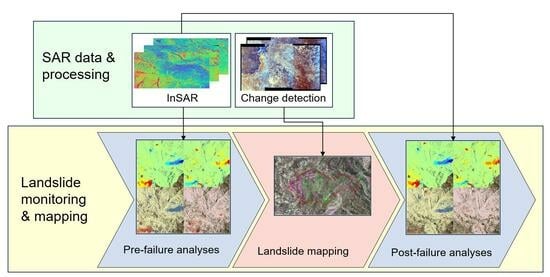Mapping and Pre- and Post-Failure Analyses of the April 2019 Kantutani Landslide in La Paz, Bolivia, Using Synthetic Aperture Radar Data
Abstract
:1. Introduction
2. Study Area and San Jorge Kantutani Landslide
3. Materials and Methods
3.1. Available Data
3.1.1. SAR Images
3.1.2. Ancillary Data
3.2. Methods
3.2.1. Change Detection
3.2.2. Two-Tier Network DSInSAR Processing
3.2.3. P-SBAS Processing
4. Results
4.1. Landslide Mapping Using the SAR Amplitude
4.2. Two-Tier Network DSInSAR Analysis
4.3. P-SBAS Analysis
4.4. San Jorge Kantutani Landslide
5. Discussion
6. Conclusions
Author Contributions
Funding
Data Availability Statement
Acknowledgments
Conflicts of Interest
References
- Cutter, S.L. Vulnerability to Environmental Hazards. Prog. Hum. Geogr. 1996, 20, 529–539. [Google Scholar] [CrossRef]
- Zhou, N.Q.; Zhao, S. Urbanization Process and Induced Environmental Geological Hazards in China. Nat. Hazards 2013, 67, 797–810. [Google Scholar] [CrossRef]
- Cascini, L.; Bonnard, C.; Corominas, J.; Jibson, R.; Montero-Olarte, J. Landslide hazard and risk zoning for urban planning and development. In Landslide Risk Management; Hungr, O., Fell, R., Couture, R., Eberhardt, E., Eds.; Taylor and Francis: London, UK, 2005; pp. 199–235. [Google Scholar]
- Coe, J.; Michael, J.; Crovelli, R.; Savage, W.; Laprade, W.; Nashem, W. Probabilistic Assessment of Precipitation-Triggered Landslides Using Historical Records of Landslide Occurrence, Seattle, Washington. Environ. Eng. Geosci. 2004, 10, 103–122. [Google Scholar] [CrossRef]
- Notti, D.; Herrera, G.; Bianchini, S.; Meisina, C.; López-Davalillo, J.C.; Zucca, F. A Methodology for Improving Landslide PSI Data Analysis. Int. J. Remote Sens. 2014, 35, 2186–2214. [Google Scholar] [CrossRef]
- Vega, J.; Hidalgo, C. Quantitative Risk Assessment of Landslides Triggered by Earthquakes and Rainfall Based on Direct Costs of Urban Buildings. Geomorphology 2016, 273, 217–235. [Google Scholar] [CrossRef]
- Li, Y.; Wang, X.; Mao, H. Influence of Human Activity on Landslide Susceptibility Development in the Three Gorges Area. Nat. Hazards J. Int. Soc. Prev. Mitig. Nat. Hazards 2020, 104, 2115–2151. [Google Scholar] [CrossRef]
- Tomás, R.; Romero, R.; Mulas, J.; Marturià, J.J.; Mallorquí, J.J.; Lopez-Sanchez, J.M.; Herrera, G.; Gutiérrez, F.; González, P.J.; Fernández, J.; et al. Radar Interferometry Techniques for the Study of Ground Subsidence Phenomena: A Review of Practical Issues through Cases in Spain. Environ. Earth Sci. 2014, 71, 163–181. [Google Scholar] [CrossRef]
- Song, C.; Yu, C.; Li, Z.; Pazzi, V.; Del Soldato, M.; Cruz, A.; Utili, S. Landslide Geometry and Activity in Villa de La Independencia (Bolivia) Revealed by InSAR and Seismic Noise Measurements. Landslides 2021, 18, 2721–2737. [Google Scholar] [CrossRef]
- Barla, G.; Antolini, F.; Barla, M. Slope Stabilization in Difficult Conditions: The Case Study of a Debris Slide in NW Italian Alps. Landslides 2013, 10, 343–355. [Google Scholar] [CrossRef]
- Wei, Z.; Shang, Y.; Sun, H.; Xu, H.; Wang, D. The Effectiveness of a Drainage Tunnel in Increasing the Rainfall Threshold of a Deep-Seated Landslide. Landslides 2019, 16, 1731–1744. [Google Scholar] [CrossRef]
- Ma, P.; Cui, Y.; Wang, W.; Lin, H.; Zhang, Y. Coupling InSAR and Numerical Modeling for Characterizing Landslide Movements under Complex Loads in Urbanized Hillslopes. Landslides 2021, 18, 1611–1623. [Google Scholar] [CrossRef]
- Intrieri, E.; Raspini, F.; Fumagalli, A.; Lu, P.; Del Conte, S.; Farina, P.; Allievi, J.; Ferretti, A.; Casagli, N. The Maoxian Landslide as Seen from Space: Detecting Precursors of Failure with Sentinel-1 Data. Landslides 2018, 15, 123–133. [Google Scholar] [CrossRef]
- Mishra, V.; Jain, K. Satellite Based Assessment of Artificial Reservoir Induced Landslides in Data Scarce Environment: A Case Study of Baglihar Reservoir in India. J. Appl. Geophys. 2022, 205, 104754. [Google Scholar] [CrossRef]
- Zhou, C.; Cao, Y.; Hu, X.; Yin, K.; Wang, Y.; Catani, F. Enhanced Dynamic Landslide Hazard Mapping Using MT-InSAR Method in the Three Gorges Reservoir Area. Landslides 2022, 19, 1585–1597. [Google Scholar] [CrossRef]
- Wang, W.; Motagh, M.; Mirzaee, S.; Li, T.; Zhou, C.; Tang, H.; Roessner, S. The 21 July 2020 Shaziba Landslide in China: Results from Multi-Source Satellite Remote Sensing. Remote Sens. Environ. 2023, 295, 113669. [Google Scholar] [CrossRef]
- Ferretti, A.; Prati, C.; Rocca, F. Permanent Scatterers in SAR Interferometry. IEEE Trans. Geosci. Remote Sens. 2001, 39, 8–20. [Google Scholar] [CrossRef]
- Berardino, P.; Fornaro, G.; Lanari, R.; Sansosti, E. A New Algorithm for Surface Deformation Monitoring Based on Small Baseline Differential SAR Interferograms. IEEE Trans. Geosci. Remote Sens. 2002, 40, 2375–2383. [Google Scholar] [CrossRef]
- Hooper, A.; Zebker, H.; Segall, P.; Kampes, B. A New Method for Measuring Deformation on Volcanoes and Other Natural Terrains Using InSAR Persistent Scatterers. Geophys. Res. Lett. 2004, 31, 23. [Google Scholar] [CrossRef]
- Ferretti, A.; Fumagalli, A.; Novali, F.; Prati, C.; Rocca, F.; Rucci, A. A New Algorithm for Processing Interferometric Data-Stacks: SqueeSAR. IEEE Trans. Geosci. Remote Sens. 2011, 49, 3460–3470. [Google Scholar] [CrossRef]
- Lv, X.; Yazıcı, B.; Zeghal, M.; Bennett, V.; Abdoun, T. Joint-Scatterer Processing for Time-Series InSAR. IEEE Trans. Geosci. Remote Sens. 2014, 52, 7205–7221. [Google Scholar] [CrossRef]
- Dong, J.; Zhang, L.; Tang, M.; Liao, M.; Xu, Q.; Gong, J.; Ao, M. Mapping Landslide Surface Displacements with Time Series SAR Interferometry by Combining Persistent and Distributed Scatterers: A Case Study of Jiaju Landslide in Danba, China. Remote Sens. Environ. 2018, 205, 180–198. [Google Scholar] [CrossRef]
- Jiang, M.; Guarnieri, A.M. Distributed Scatterer Interferometry with the Refinement of Spatiotemporal Coherence. IEEE Trans. Geosci. Remote Sens. 2020, 58, 3977–3987. [Google Scholar] [CrossRef]
- Hooper, A.; Bekaert, D.; Spaans, K.; Arıkan, M. Recent Advances in SAR Interferometry Time Series Analysis for Measuring Crustal Deformation. Tectonophysics 2012, 514–517, 1–13. [Google Scholar] [CrossRef]
- Di Traglia, F.; Nolesini, T.; Intrieri, E.; Mugnai, F.; Leva, D.; Rosi, M.; Casagli, N. Review of Ten Years of Volcano Deformations Recorded by the Ground-Based InSAR Monitoring System at Stromboli Volcano: A Tool to Mitigate Volcano Flank Dynamics and Intense Volcanic Activity. Earth-Sci. Rev. 2014, 139, 317–335. [Google Scholar] [CrossRef]
- Dai, K.; Liu, G.; Li, Z.; Ma, D.; Wang, X.; Zhang, B.; Tang, J.; Li, G. Monitoring Highway Stability in Permafrost Regions with X-Band Temporary Scatterers Stacking InSAR. Sensors 2018, 18, 1876. [Google Scholar] [CrossRef]
- Raspini, F.; Bianchini, S.; Ciampalini, A.; Del Soldato, M.; Solari, L.; Novali, F.; Del Conte, S.; Rucci, A.; Ferretti, A.; Casagli, N. Continuous, Semi-Automatic Monitoring of Ground Deformation Using Sentinel-1 Satellites. Sci. Rep. 2018, 8, 7253. [Google Scholar] [CrossRef]
- Bischoff, C.A.; Ferretti, A.; Novali, F.; Uttini, A.; Giannico, C.; Meloni, F. Nationwide Deformation Monitoring with SqueeSAR® Using Sentinel-1 Data. Proc. Int. Assoc. Hydrol. Sci. 2020, 382, 31–37. [Google Scholar] [CrossRef]
- Confuorto, P.; Di Martire, D.; Centolanza, G.; Iglesias, R.; Mallorqui, J.J.; Novellino, A.; Plank, S.; Ramondini, M.; Thuro, K.; Calcaterra, D. Post-Failure Evolution Analysis of a Rainfall-Triggered Landslide by Multi-Temporal Interferometry SAR Approaches Integrated with Geotechnical Analysis. Remote Sens. Environ. 2017, 188, 51–72. [Google Scholar] [CrossRef]
- Yamaguchi, Y. Disaster Monitoring by Fully Polarimetric SAR Data Acquired With ALOS-PALSAR. Proc. IEEE 2012, 100, 2851–2860. [Google Scholar] [CrossRef]
- White, R.G. Change Detection in SAR Imagery. Int. J. Remote Sens. 1991, 12, 339–360. [Google Scholar] [CrossRef]
- Rignot, E.J.M.; Van Zyl, J.J. Change Detection Techniques for ERS-1 SAR Data. IEEE Trans. Geosci. Remote Sens. 1993, 31, 896–906. [Google Scholar] [CrossRef]
- Plank, S.; Twele, A.; Martinis, S. Landslide Mapping in Vegetated Areas Using Change Detection Based on Optical and Polarimetric SAR Data. Remote Sens. 2016, 8, 307. [Google Scholar] [CrossRef]
- Di Traglia, F.; Nolesini, T.; Ciampalini, A.; Solari, L.; Frodella, W.; Bellotti, F.; Fumagalli, A.; De Rosa, G.; Casagli, N. Tracking Morphological Changes and Slope Instability Using Spaceborne and Ground-Based SAR Data. Geomorphology 2018, 300, 95–112. [Google Scholar] [CrossRef]
- Handwerger, A.L.; Jones, S.Y.; Huang, M.-H.; Amatya, P.; Kerner, H.R.; Kirschbaum, D.B. Rapid Landslide Identification Using Synthetic Aperture Radar Amplitude Change Detection on the Google Earth Engine. Nat. Hazards Earth Syst. Sci. Discuss. 2020, 2020, 1–24. [Google Scholar] [CrossRef]
- Euillades, P.; Euillades, L.; Pepe, A.; Mastro, P.; Falabella, F.; Imperatore, P.; Tang, Y.; Rosell, P. Recent Advancements in Multi-Temporal Methods Applied to New Generation SAR Systems and Applications in South America. J. South Am. Earth Sci. 2021, 111, 103410. [Google Scholar] [CrossRef]
- Pazzi, V.; Del Soldato, M.; Song, C.; Yu, C.; Li, Z.; Cruz, A.; Utili, S. InSAR, Seismic Noise, and Geotechnical Data to Assess Landslide Activity and Geometry: The Villa de Independencia (Cochabamba, Bolivia) Case Study. In Proceedings of the vvEGU21, the 23rd EGU General Assembly, Online, 19–30 April 2021. EGU21-12300. [Google Scholar] [CrossRef]
- Cigna, F.; Tapete, D. Sentinel-1 Big Data Processing with P-SBAS InSAR in the Geohazards Exploitation Platform: An Experiment on Coastal Land Subsidence and Landslides in Italy. Remote Sens. 2021, 13, 885. [Google Scholar] [CrossRef]
- Wu, P.-C.; Wei, M.; D’Hondt, S. Subsidence in Coastal Cities throughout the World Observed by InSAR. Geophys. Res. Lett. 2022, 49, e2022GL098477. [Google Scholar] [CrossRef]
- Nathan, F. Risk Perception, Risk Management and Vulnerability to Landslides in the Hill Slopes in the City of La Paz, Bolivia. A Preliminary Statement. Disasters 2008, 32, 337–357. [Google Scholar] [CrossRef]
- Hermanns, R.; Dehls, J.; Guzman, M.; Roberts, N.; Clague, J.; Cazas, S.A.; Quenta, Q.G. Relation of Recent Megalandslides to Prehistoric Events in the City of La Paz, Bolivia. In Proceedings of the 2nd North American Symposium on Landslides, Banff, AB, Canada, 3–8 June 2012; pp. 265–271. [Google Scholar]
- Roberts, N.J.; Rabus, B.T.; Clague, J.J.; Hermanns, R.L.; Guzmán, M.-A.; Minaya, E. Changes in Ground Deformation Prior to and Following a Large Urban Landslide in La Paz, Bolivia, Revealed by Advanced InSAR. Nat. Hazards Earth Syst. Sci. 2019, 19, 679–696. [Google Scholar] [CrossRef]
- Huang Lin, C.; Liu, D.; Liu, G. Landslide Detection in La Paz City (Bolivia) Based on Time Series Analysis of InSAR Data. Int. J. Remote Sens. 2019, 40, 6775–6795. [Google Scholar] [CrossRef]
- Casu, F.; Elefante, S.; Imperatore, P.; Zinno, I.; Manunta, M.; De Luca, C.; Lanari, R. SBAS-DInSAR Parallel Processing for Deformation Time-Series Computation. IEEE J. Sel. Top. Appl. Earth Obs. Remote Sens. 2014, 7, 3285–3296. [Google Scholar] [CrossRef]
- Zinno, I.; Elefante, S.; Mossucca, L.; De Luca, C.; Manunta, M.; Terzo, O.; Lanari, R.; Casu, F. A First Assessment of the P-SBAS DInSAR Algorithm Performances within a Cloud Computing Environment. IEEE J. Sel. Top. Appl. Earth Obs. Remote Sens. 2015, 8, 4675–4686. [Google Scholar] [CrossRef]
- Manunta, M.; De Luca, C.; Zinno, I.; Casu, F.; Manzo, M.; Bonano, M.; Fusco, A.; Pepe, A.; Onorato, G.; Berardino, P.; et al. The Parallel SBAS Approach for Sentinel-1 Interferometric Wide Swath Deformation Time-Series Generation: Algorithm Description and Products Quality Assessment. IEEE Trans. Geosci. Remote Sens. 2019, 57, 6259–6281. [Google Scholar] [CrossRef]
- Ma, P.; Wang, W.; Zhang, B.; Wang, J.; Shi, G.; Huang, G.; Chen, F.; Jiang, L.; Lin, H. Remotely Sensing Large- and Small-Scale Ground Subsidence: A Case Study of the Guangdong–Hong Kong–Macao Greater Bay Area of China. Remote Sens. Environ. 2019, 232, 111282. [Google Scholar] [CrossRef]
- Forno, E.; Baudoin, M. Historia Natural de un Valle En Los Andes: La Paz; Instituto de Ecología Universidad Mayor de San Andrés: La Paz, Bolivia, 1991. [Google Scholar]
- Roberts, N.J. Late Cenozoic Geology of La Paz, Bolivia, and Its Relation to Landslide Activity. Available online: https://summit.sfu.ca/item/16449 (accessed on 1 October 2023).
- Roberts, N.J.; Rabus, B.; Hermanns, R.L.; Guzmán, M.-A.; Clague, J.J.; Minaya, E. Recent Landslide Activity in La Paz, Bolivia. In Landslide Science for a Safer Geoenvironment; Sassa, K., Canuti, P., Yin, Y., Eds.; Springer International Publishing: Cham, Switzerland, 2014; pp. 431–437. [Google Scholar]
- O’hare, G.; Rivas, S. The Landslide Hazard and Human Vulnerability in La Paz City, Bolivia. Geogr. J. 2005, 171, 239–258. [Google Scholar] [CrossRef]
- Quenta, Q.G.; Galarza, I.; Teran, N.; Hermanns, R.L.; Cazaz, A.; Garcia, H. Translational Landslide and Damming in the Allpacoma Valley, City of La Paz, Bolivia. Mov. Masa Región Andin. Guía Para Eval. Amenazas Proy. Multinac. Andino Geocienc. Para Las Comunidades Andin. Serv. Nac. Geol. Min. Santiago Chile Publ. Geológica Multinac. 2007, 4, 230–234. [Google Scholar]
- Cruden, D.M.; Varnes, D.J. Landslides: Investigation and Mitigation; Chapter 3-Landslide Types and Processes; Transportation Research Board Special Report; The National Academies of Sciences, Engineering, and Medicine: Washington, DC, USA, 1996. [Google Scholar]
- GAMLP. Informe Técnico: Recopilación Bibliográfica Características Geológicas Valle de la Paz Y Zona de Kantutani; GAMLP: La Paz, Bolivia, 2019. [Google Scholar]
- Aparicio-Effen, M.; Arana, I.; Aparicio, J.; Ocampo, M.; Roque, S.; Nagy, G. A Successful Early Warning System for Hydroclimatic Extreme Events: The Case of La Paz City Mega Landslide; Springer: Cham, Switzerland, 2018; pp. 241–264. ISBN 978-3-319-56945-1. [Google Scholar]
- Gran Deslizamiento En San Jorge-Kantutani Destruye Viviendas En La Paz. Available online: https://www.urgente.bo/noticia/gran-deslizamiento-en-san-jorge-kantutani-destruye-viviendas-en-la-paz (accessed on 1 August 2023).
- Mediante Ley El Concejo Municipal Refrenda Declaratoria de Alerta Roja En Área de Deslizamiento. Available online: https://www.concejomunicipal.bo/2019/05/08/mediante-ley-el-concejo-municipal-refrenda-declaratoria-de-alerta-roja-en-area-de-deslizamiento/ (accessed on 1 August 2023).
- El Deslizamiento En Kantutani Es El Tercero Más Grave; Declaran Desastre. Available online: https://www.lostiempos.com/actualidad/pais/20190502/deslizamiento-kantutani-es-tercero-mas-grave-declaran-desastre (accessed on 1 August 2023).
- Un Nuevo Deslizamiento Arrastra Varias Viviendas En Bajo LLojeta y Deja Dos Desaparecidos. Available online: https://www.radiointegracion.com/un-nuevo-deslizamiento-arrastra-varias-viviendas-en-bajo-llojeta-y-deja-dos-desaparecidos/ (accessed on 1 August 2023).
- Milillo, P.; Fielding, E.J.; Shulz, W.H.; Delbridge, B.; Burgmann, R. COSMO-SkyMed Spotlight Interferometry Over Rural Areas: The Slumgullion Landslide in Colorado, USA. IEEE J. Sel. Top. Appl. Earth Obs. Remote Sens. 2014, 7, 2919–2926. [Google Scholar] [CrossRef]
- Torres, R.; Snoeij, P.; Geudtner, D.; Bibby, D.; Davidson, M.; Attema, E.; Potin, P.; Rommen, B.; Floury, N.; Brown, M.; et al. GMES Sentinel-1 Mission. Remote Sens. Environ. 2012, 120, 9–24. [Google Scholar] [CrossRef]
- Morishita, Y.; Lazecky, M.; Wright, T.J.; Weiss, J.R.; Elliott, J.R.; Hooper, A. LiCSBAS: An Open-Source InSAR Time Series Analysis Package Integrated with the LiCSAR Automated Sentinel-1 InSAR Processor. Remote Sens. 2020, 12, 424. [Google Scholar] [CrossRef]
- ESA Copernicus Open Access Hub. Available online: https://scihub.copernicus.eu/dhus/#/home (accessed on 1 August 2023).
- Drusch, M.; Del Bello, U.; Carlier, S.; Colin, O.; Fernandez, V.; Gascon, F.; Hoersch, B.; Isola, C.; Laberinti, P.; Martimort, P.; et al. Sentinel-2: ESA’s Optical High-Resolution Mission for GMES Operational Services. Remote Sens. Environ. 2012, 120, 25–36. [Google Scholar] [CrossRef]
- Phiri, D.; Simwanda, M.; Salekin, S.; Nyirenda, V.R.; Murayama, Y.; Ranagalage, M. Sentinel-2 Data for Land Cover/Use Mapping: A Review. Remote Sens. 2020, 12, 2291. [Google Scholar] [CrossRef]
- Sentinel Hub. Available online: www.sentinel-hub.com (accessed on 1 August 2023).
- Gomes, V.C.F.; Queiroz, G.R.; Ferreira, K.R. An Overview of Platforms for Big Earth Observation Data Management and Analysis. Remote Sens. 2020, 12, 1253. [Google Scholar] [CrossRef]
- Wadge, G.; Scheuchl, B.; Stevens, N.F. Spaceborne Radar Measurements of the Eruption of Soufrière Hills Volcano, Montserrat. Geol. Soc. Lond. Mem. 2002, 21, 583–594. [Google Scholar] [CrossRef]
- Bignami, C.; Corradini, S.; Merucci, L.; de Michele, M.; Raucoules, D.; De Astis, G.; Stramondo, S.; Piedra, J. Multisensor Satellite Monitoring of the 2011 Puyehue-Cordon Caulle Eruption. IEEE J. Sel. Top. Appl. Earth Obs. Remote Sens. 2014, 7, 2786–2796. [Google Scholar] [CrossRef]
- Misra, A.; Balaji, R. Simple Approaches to Oil Spill Detection Using Sentinel Application Platform (SNAP)-Ocean Application Tools and Texture Analysis: A Comparative Study. J. Indian Soc. Remote Sens. 2017, 45, 1065–1075. [Google Scholar] [CrossRef]
- Numbisi, F.N.; Van Coillie, F.M.B.; De Wulf, R. Delineation of Cocoa Agroforests Using Multiseason Sentinel-1 SAR Images: A Low Grey Level Range Reduces Uncertainties in GLCM Texture-Based Mapping. ISPRS Int. J. Geo-Inf. 2019, 8, 179. [Google Scholar] [CrossRef]
- Haralick, R.M.; Shanmugam, K.; Dinstein, I. Textural Features for Image Classification. IEEE Trans. Syst. Man Cybern. 1973, 6, 610–621. [Google Scholar] [CrossRef]
- Zhang, B.; Wang, R.; Deng, Y.; Ma, P.; Lin, H.; Wang, J. Mapping the Yellow River Delta Land Subsidence with Multitemporal SAR Interferometry by Exploiting Both Persistent and Distributed Scatterers. ISPRS J. Photogramm. Remote Sens. 2019, 148, 157–173. [Google Scholar] [CrossRef]
- Yu, C.; Penna, N.T.; Li, Z. Generation of Real-Time Mode High-Resolution Water Vapor Fields from GPS Observations. J. Geophys. Res. Atmos. 2017, 122, 2008–2025. [Google Scholar] [CrossRef]
- Yu, C.; Li, Z.; Penna, N.T.; Crippa, P. Generic Atmospheric Correction Model for Interferometric Synthetic Aperture Radar Observations. J. Geophys. Res. Solid Earth 2018, 123, 9202–9222. [Google Scholar] [CrossRef]
- Yu, C.; Li, Z.; Penna, N.T. Interferometric Synthetic Aperture Radar Atmospheric Correction Using a GPS-Based Iterative Tropospheric Decomposition Model. Remote Sens. Environ. 2018, 204, 109–121. [Google Scholar] [CrossRef]
- Wright, T.J.; Parsons, B.E.; Lu, Z. Toward Mapping Surface Deformation in Three Dimensions Using InSAR. Geophys. Res. Lett. 2004, 31, 1. [Google Scholar] [CrossRef]
- Geohazards TEP. Available online: https://geohazards-tep.eu/ (accessed on 1 August 2023).
- De Luca, C.; Cuccu, R.; Elefante, S.; Zinno, I.; Manunta, M.; Casola, V.; Rivolta, G.; Lanari, R.; Casu, F. An On-Demand Web Tool for the Unsupervised Retrieval of Earth’s Surface Deformation from SAR Data: The P-SBAS Service within the ESA G-POD Environment. Remote Sens. 2015, 7, 15630–15650. [Google Scholar] [CrossRef]
- Foumelis, M.; Papadopoulou, T.; Bally, P.; Pacini, F.; Provost, F.; Patruno, J. Monitoring Geohazards Using On-Demand and Systematic Services on Esa’s Geohazards Exploitation Platform. In Proceedings of the IGARSS 2019—2019 IEEE International Geoscience and Remote Sensing Symposium, Yokohama, Japan, 28 July–2 August 2019; pp. 5457–5460. [Google Scholar]
- Wasowski, J.; Bovenga, F. Investigating Landslides and Unstable Slopes with Satellite Multi Temporal Interferometry: Current Issues and Future Perspectives. Eng. Geol. 2014, 174, 103–138. [Google Scholar] [CrossRef]
- Dai, K.; Deng, J.; Xu, Q.; Li, Z.; Shi, X.; Hancock, C.; Wen, N.; Zhang, L.; Zhuo, G. Interpretation and Sensitivity Analysis of the InSAR Line of Sight Displacements in Landslide Measurements. GISci. Remote Sens. 2022, 59, 1226–1242. [Google Scholar] [CrossRef]
- Eckerstorfer, M.; Malnes, E.; Müller, K. A Complete Snow Avalanche Activity Record from a Norwegian Forecasting Region Using Sentinel-1 Satellite-Radar Data. Cold Reg. Sci. Technol. 2017, 144, 39–51. [Google Scholar] [CrossRef]
- Mondini, A.C.; Santangelo, M.; Rocchetti, M.; Rossetto, E.; Manconi, A.; Monserrat, O. Sentinel-1 SAR Amplitude Imagery for Rapid Landslide Detection. Remote Sens. 2019, 11, 760. [Google Scholar] [CrossRef]
- Handwerger, A.L.; Huang, M.-H.; Jones, S.Y.; Amatya, P.; Kerner, H.R.; Kirschbaum, D.B. Generating Landslide Density Heatmaps for Rapid Detection Using Open-Access Satellite Radar Data in Google Earth Engine. Nat. Hazards Earth Syst. Sci. 2022, 22, 753–773. [Google Scholar] [CrossRef]
- Zhao, R.; Li, Z.; Feng, G.; Wang, Q.; Hu, J. Monitoring Surface Deformation over Permafrost with an Improved SBAS-InSAR Algorithm: With Emphasis on Climatic Factors Modeling. Remote Sens. Environ. 2016, 184, 276–287. [Google Scholar] [CrossRef]
- Bianchini, S.; Raspini, F.; Solari, L.; Del Soldato, M.; Ciampalini, A.; Rosi, A.; Casagli, N. From Picture to Movie: Twenty Years of Ground Deformation Recording Over Tuscany Region (Italy) With Satellite InSAR. Front. Earth Sci. 2018, 6, 177. [Google Scholar] [CrossRef]
- Kang, Y.; Lu, Z.; Zhao, C.; Xu, Y.; Kim, J.; Gallegos, A.J. InSAR Monitoring of Creeping Landslides in Mountainous Regions: A Case Study in Eldorado National Forest, California. Remote Sens. Environ. 2021, 258, 112400. [Google Scholar] [CrossRef]
- Xiao, T.; Huang, W.; Deng, Y.; Tian, W.; Sha, Y. Long-Term and Emergency Monitoring of Zhongbao Landslide Using Space-Borne and Ground-Based InSAR. Remote Sens. 2021, 13, 1578. [Google Scholar] [CrossRef]
- Lazecký, M.; Spaans, K.; González, P.J.; Maghsoudi, Y.; Morishita, Y.; Albino, F.; Elliott, J.; Greenall, N.; Hatton, E.; Hooper, A.; et al. LiCSAR: An Automatic InSAR Tool for Measuring and Monitoring Tectonic and Volcanic Activity. Remote Sens. 2020, 12, 2430. [Google Scholar] [CrossRef]
- Hogenson, K.; Arko, S.A.; Buechler, B.; Hogenson, R.; Herrmann, J.; Geiger, A. Hybrid Pluggable Processing Pipeline (HyP3): A Cloud-Based Infrastructure for Generic Processing of SAR Data. In Proceedings of the AGU Fall Meeting Abstract, San Francisco, CA, USA, 12–16 December 2016. IN21B-1740. [Google Scholar]
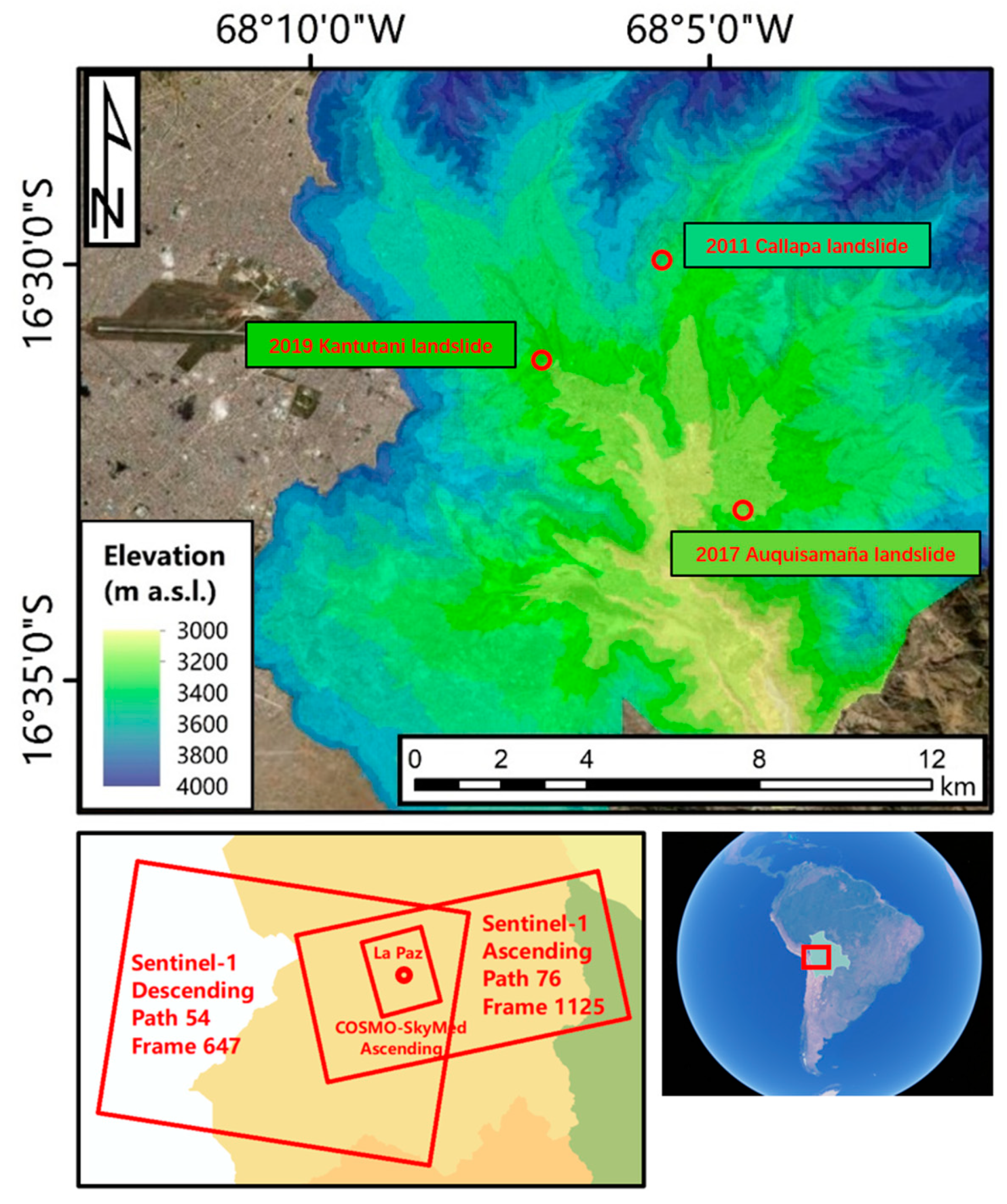

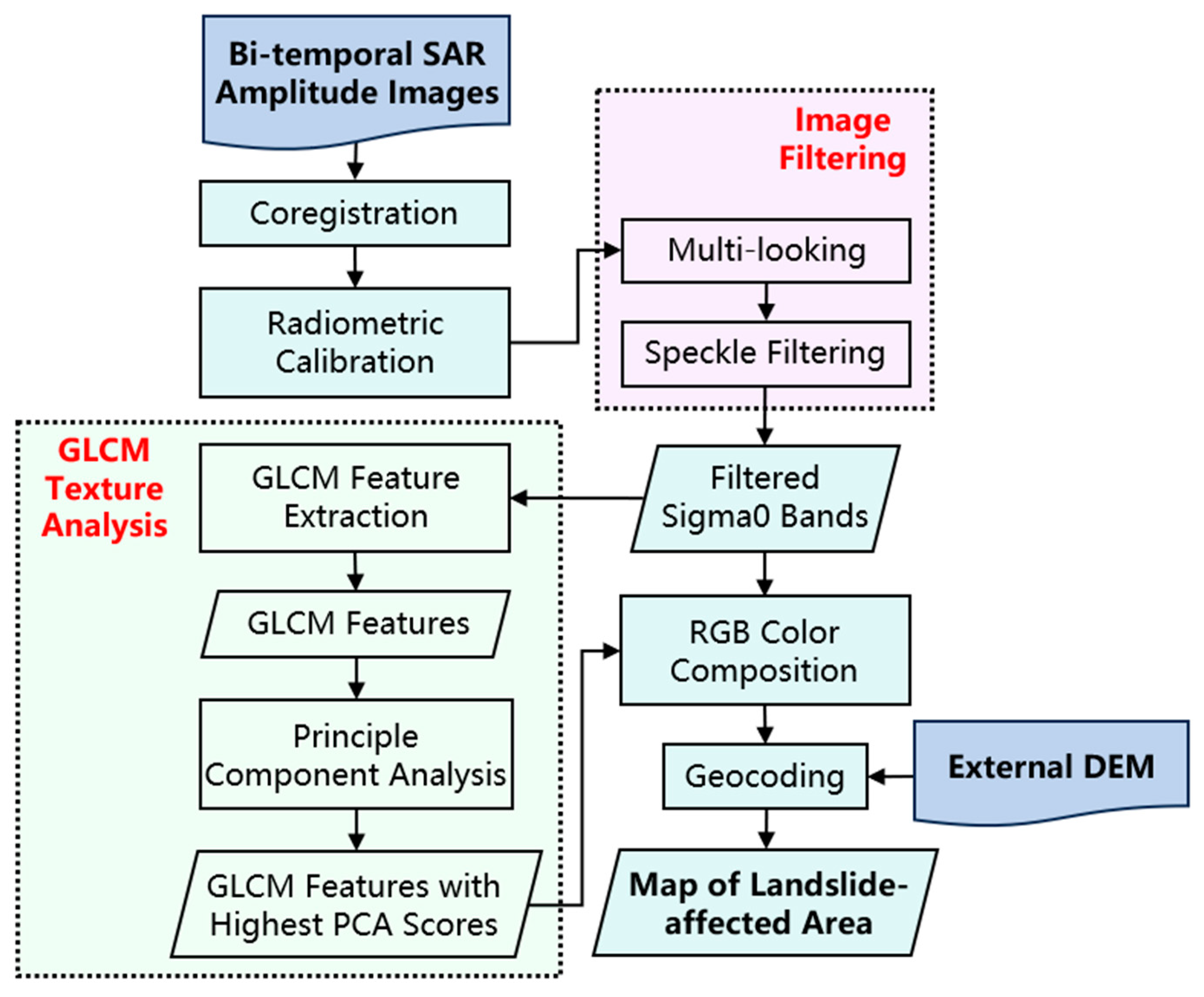

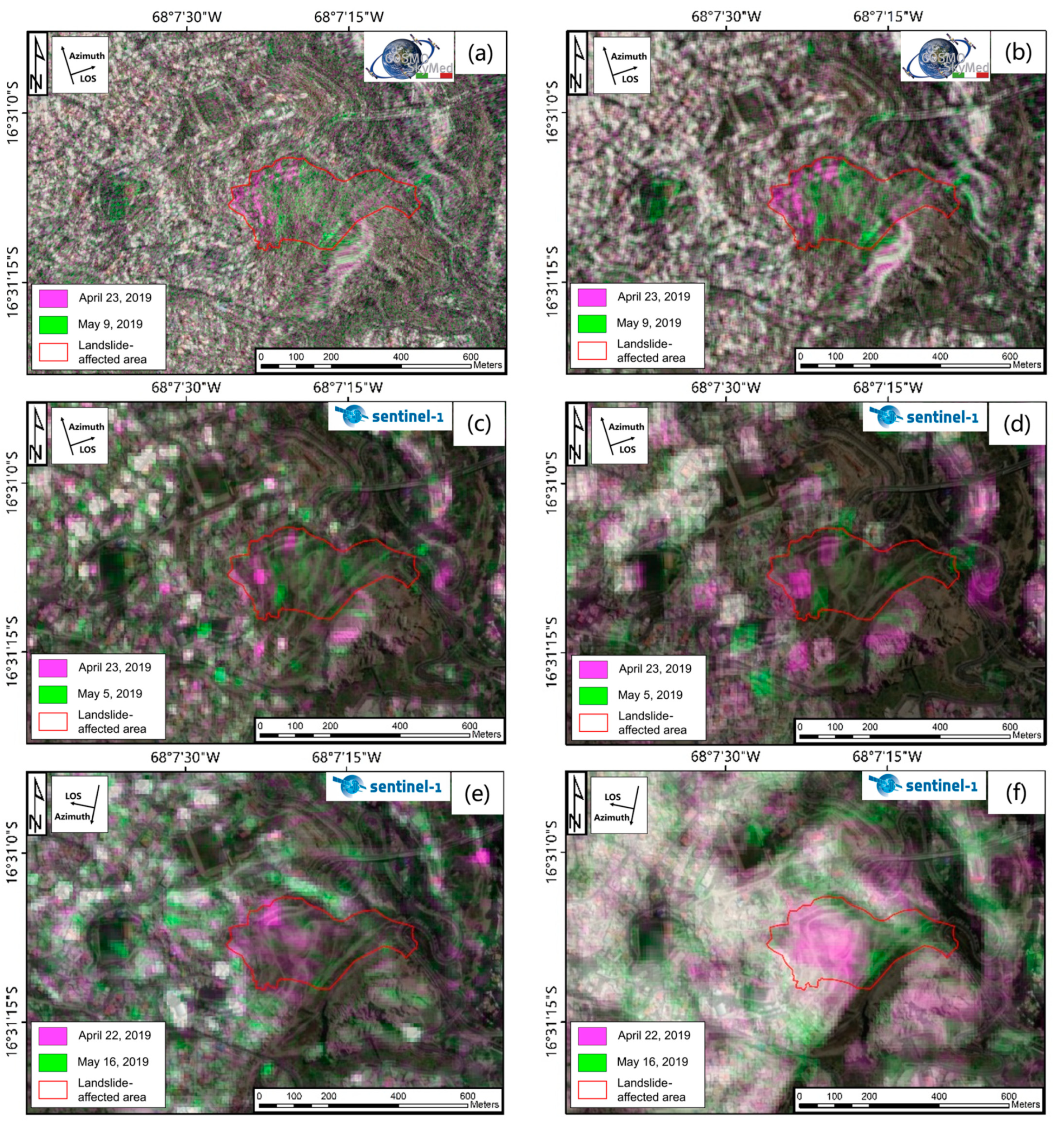
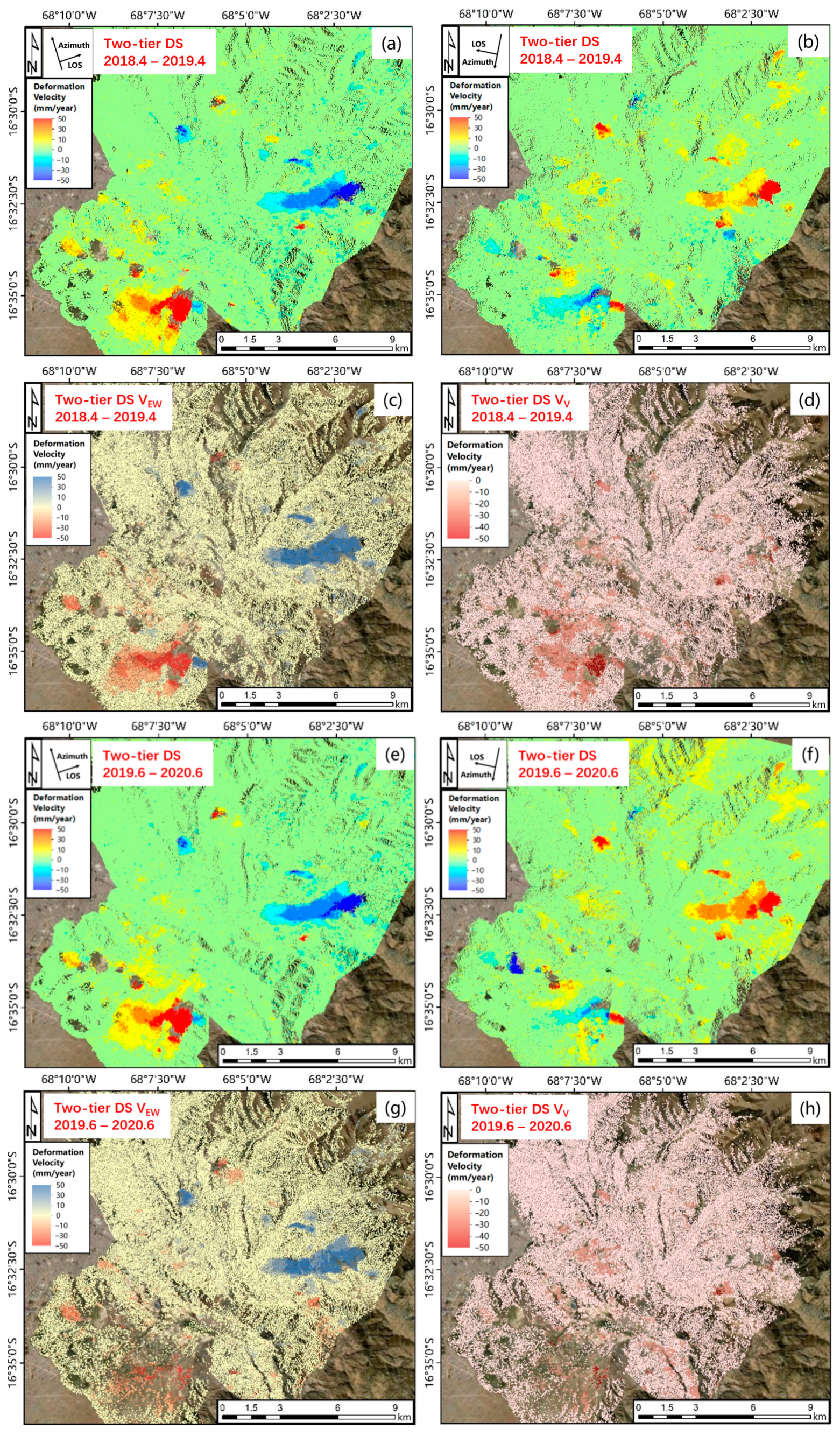

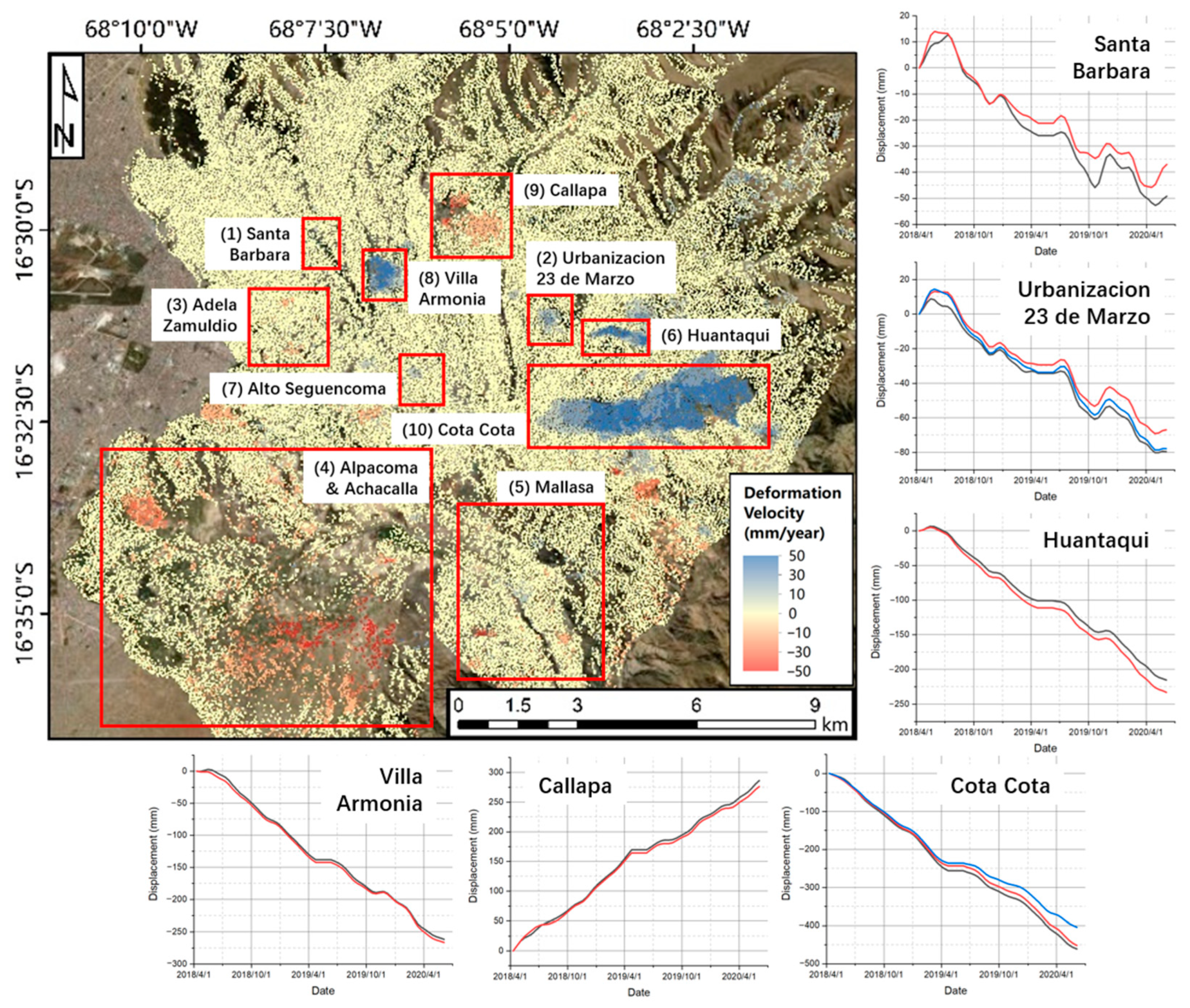
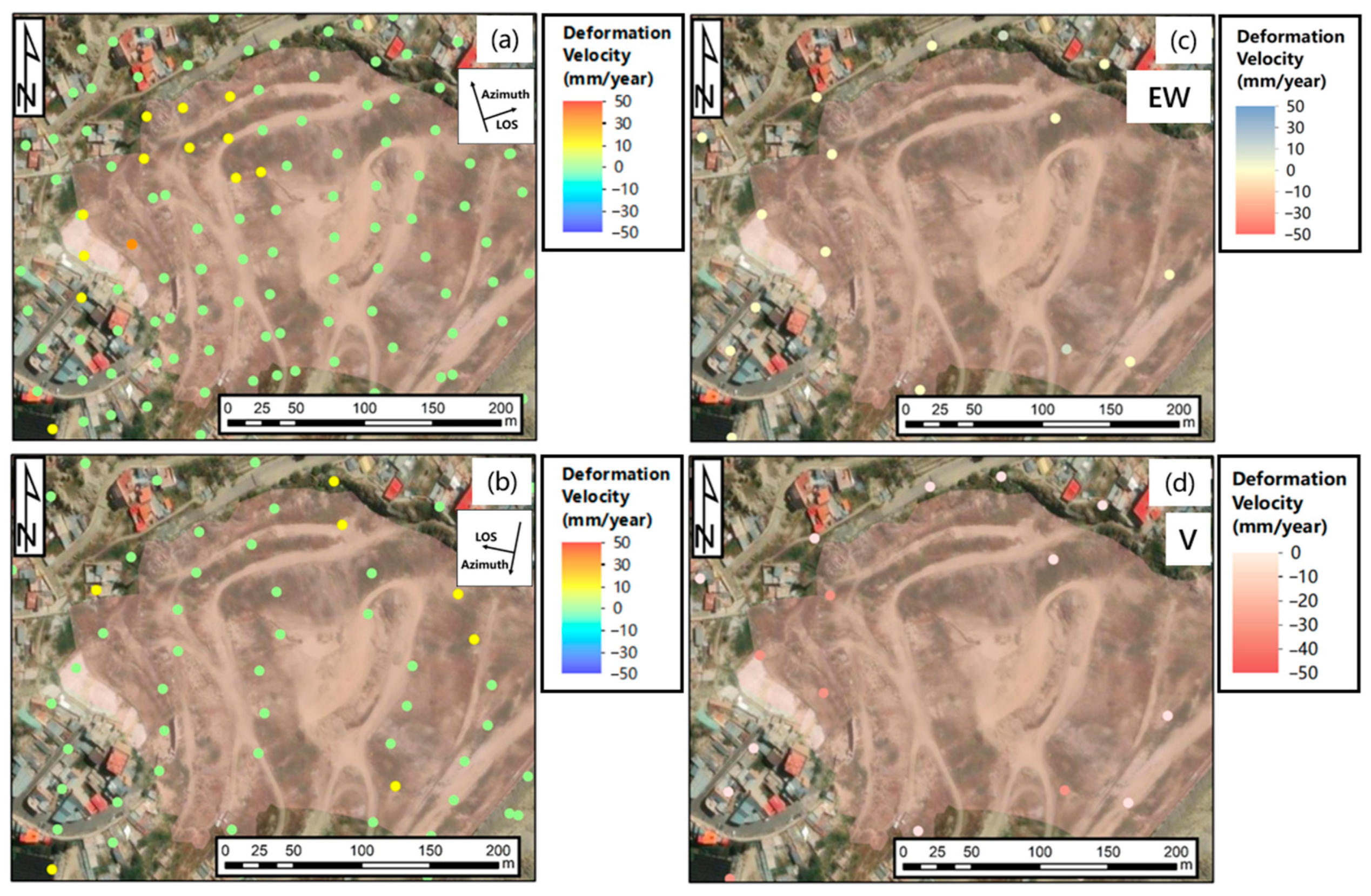
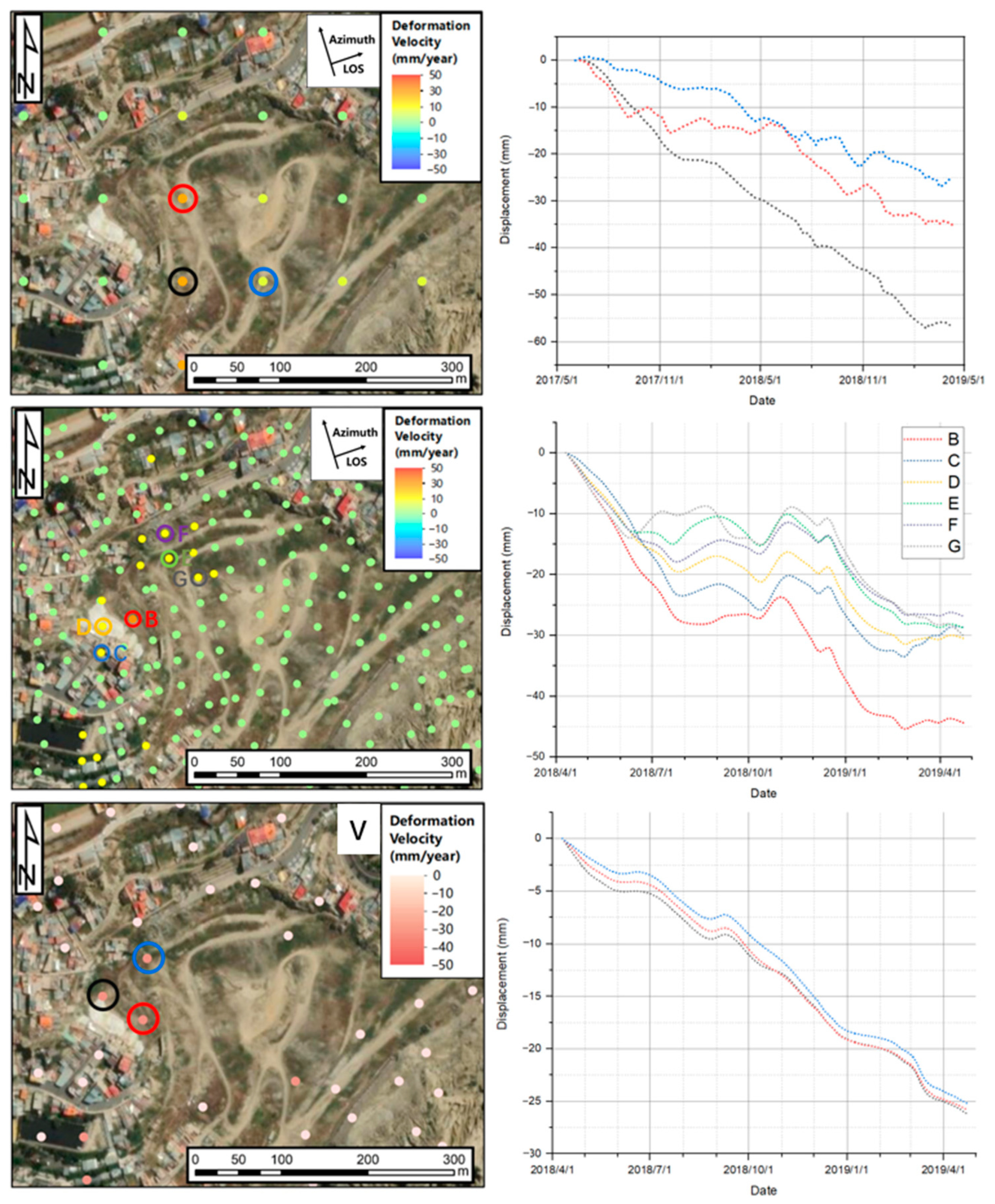

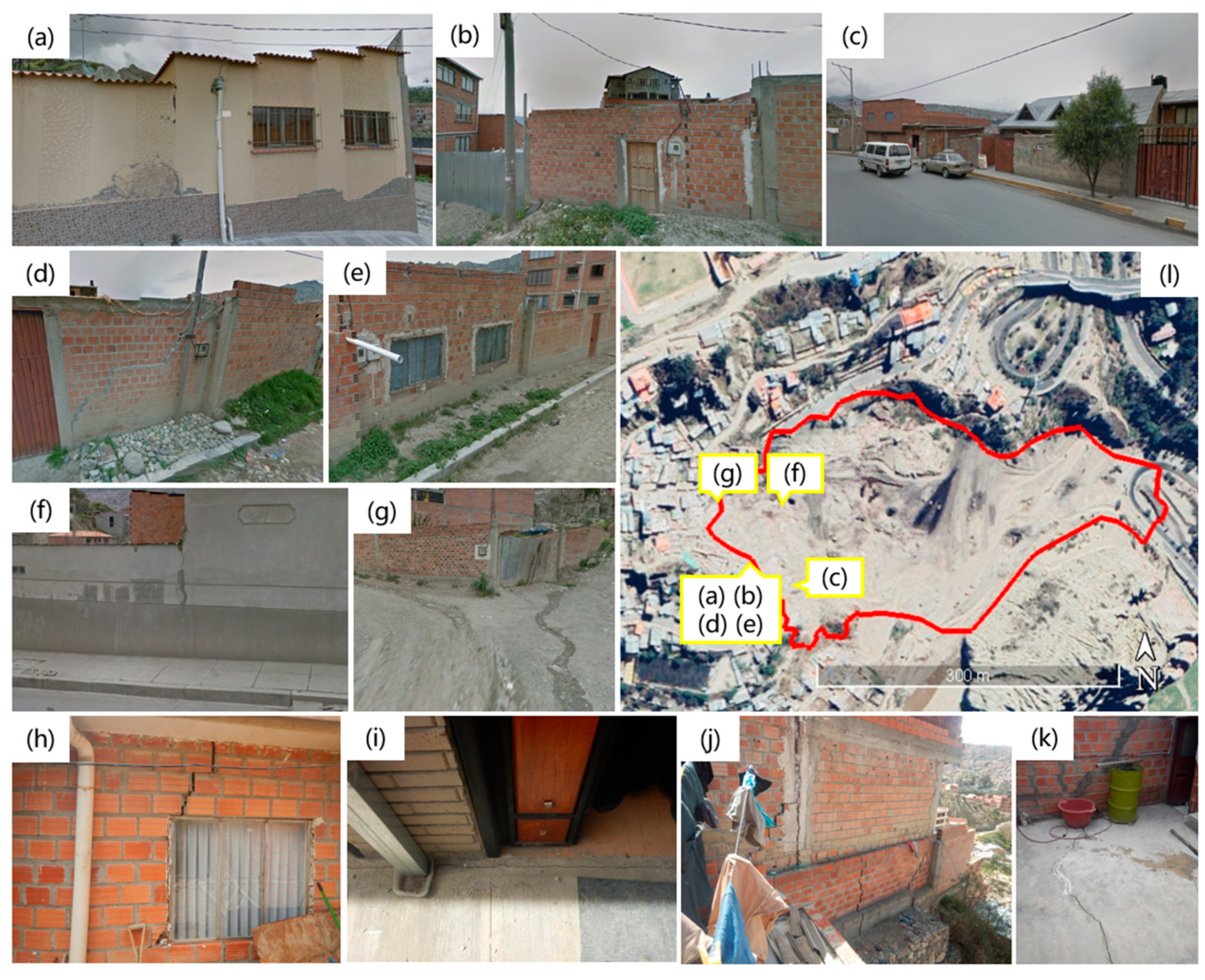


| Location | Date of Triggering | Affects | Extent (km2) |
|---|---|---|---|
| Callapa, Pampahasi | 26 February 2011 | 1000 houses were destroyed, 2237 properties were affected and more than 6000 families have been relocated [43] | 1.5 |
| Auquisamaña | 15 February 2017 | 5 houses were buried but no casualties were reported | 0.02 |
| Kantutani | 30 April 2019 | 80 families were affected, 380 occupants were evacuated, no deaths, serious injuries, or disappearances were recorded | 0.09 |
| Band | Imaging Mode | Pre-Failure | Post-Failure | Temporal Interval | Orbit | Resolution | |
|---|---|---|---|---|---|---|---|
| COSMO-SkyMed | X | Stripmap HIMAGE | 23 April 2019 | 9 May 2019 | 16 days | Ascending | 3 × 3 m |
| Sentinel-1 | C | GRD | 23 April 2019 | 5 May 2019 | 12 days | Ascending | 10 × 10 m |
| 23 April 2019 | 16 May 2019 | 24 days | Descending |
| Pre-Failure | Post-Failure | Orbit | Number of Images | Resolution | |
|---|---|---|---|---|---|
| Two-Tier Network DSInSAR | April 2018 to April 2019 | June 2019 to June 2020 | Ascending | 69 (31 pre-failure, 38 post-failure) | 40 × 50 m |
| April 2018 to April 2019 | June 2019 to June 2020 | Descending | 69 (31 pre-failure, 38 post-failure) | ||
| P-SBAS | April 2017 to April 2019 | June 2019 to May 2021 | Ascending | 127 (66 pre-failure, 61 post-failure) | 90 × 90 m |
| April 2017 to April 2019 | June 2019 to May 2021 | Descending | 137 (76 pre-failure, 61 post-failure) |
| Red | Green | Blue |
|---|---|---|
| Pre-failure calibrated amplitude sigma0 | Post-failure calibrated amplitude sigma0 | Pre-failure calibrated amplitude sigma0 |
| Pre-event GLCM texture features with high PCA scores | Post-event GLCM texture features with high PCA scores | Pre-event GLCM texture features with high PCA scores |
| COSMO-SkyMed | Sentinel-1 Ascending | Sentinel-1 Descending | ||||
|---|---|---|---|---|---|---|
| Pre-Failure | Post-Failure | Pre-Failure | Post-Failure | Pre-Failure | Post-Failure | |
| GLCM variance | 653.83 | 603.19 | 166.51 | 132.85 | 60.12 | 64.06 |
| Contrast | 214.19 | 214.94 | 122.75 | 96.46 | 53.07 | 57.72 |
| GLCM mean | 31.11 | 29.43 | 12.16 | 10.47 | 7.18 | 7.39 |
| Creep Hotspots | Official Risk Map (2011) | DSInSAR LOS (mm/Year) | DSInSAR Projected (mm/Year) | P-SBAS LOS (mm/Year) | ||||
|---|---|---|---|---|---|---|---|---|
| S-1 Asc | S-1 Desc | E-W | U-D | S-1 Asc | S-1 Desc | |||
| 1 | Santa Barbara | Very High | 23.05 | −35.17 | −34.25 | −27.85 | 20.23 | −22.47 |
| 2 | Urbanizacion 23 de Marzo | Very High | 33.3 | −57.93 | −43.65 | −29.4 | 29.78 | −50.69 |
| 3 | Adela Zamuldio, Cotahuma | Mixed | −49.72 | 13.37 | 12.77 | −29.06 | −11.57 | 0.97 |
| 4 | Alpacoma and north of Achacalla Basin | Very High | −162.59/ 55.62 | −142.22/ 77.12 | −106.95/ 150.61 | −112.34 | −234.14/ 52.7 | −164.58/ 158.25 |
| 5 | Mallasa | Very High | −53.01 | −59.02 | −44.77 | −42.13 | −38.36 | −78.3 |
| 6 | Huantaqui | Very High | 63.76 | −77.85 | −101.24 | −53.68 | 73.9 | −93.38 |
| 7 | Alto Seguencoma | Mixed | 20.29 | −52.52 | −33.51 | −42.66 | 15.59 | −41.57 |
| 8 | Villa Armonia | Very High | 78.69 | −109.56 | −124.75 | −50.9 | 70.23 | −126.03 |
| 9 | Callapa | Very High | −132.43 | 71.12 | 150.98 | −81.87 | −124.32 | 54.15 |
| 10 | Cota Cota | Very High | 128.53 | −154.19 | −216.27 | −88.39 | 171.10 | −177.46 |
| Creep Hotspots | Official Risk Map (2011) | DSInSAR LOS (mm/Year) | DSInSAR Projected (mm/Year) | P-SBAS LOS (mm/Year) | ||||
|---|---|---|---|---|---|---|---|---|
| S-1 Asc | S-1 Desc | E-W | U-D | S-1 Asc | S-1 Desc | |||
| 1 | Santa Barbara | Very High | 27.18 | −29.49 | −24 | −24 | 10.88 | −21.27 |
| 2 | Urbanizacion 23 de Marzo | Very High | 33.18 | −42.28 | −39.69 | −31.44 | 25.61 | −41.87 |
| 3 | Adela Zamuldio, Cotahuma | Mixed | −14.21 | 9.37 | 14.04 | −19.66 | −10.27 | 6.64 |
| 4 | Alpacoma and north of Achacalla Basin | Very High | −176.65/ 45.38 | −90.22/ 87.34 | −77.31/ 186.61 | −110.25 | −215.15/ 44.5 | −103.56/ 74.48 |
| 5 | Mallasa | Very High | −72.18 | −91 | −63.84 | −55.02 | −31.9 | −49.48 |
| 6 | Huantaqui | Very High | 72.82 | −82.05 | −108.44 | −37.63 | 77.7 | −93.27 |
| 7 | Alto Seguencoma | Mixed | 25.5 | −39.97 | −27.1 | −41.12 | 10.26 | −37.41 |
| 8 | Villa Armonia | Very High | 69.22 | −116.69 | −126.46 | −41.09 | 55.88 | −86.88 |
| 9 | Callapa | Very High | −79.41 | 101.07 | 107.46 | −44.43 | −196.84 | 125.94 |
| 10 | Cota Cota | Very High | 138.18 | −127.75 | −200.58 | −88.73 | 157.38 | −174.02 |
Disclaimer/Publisher’s Note: The statements, opinions and data contained in all publications are solely those of the individual author(s) and contributor(s) and not of MDPI and/or the editor(s). MDPI and/or the editor(s) disclaim responsibility for any injury to people or property resulting from any ideas, methods, instructions or products referred to in the content. |
© 2023 by the authors. Licensee MDPI, Basel, Switzerland. This article is an open access article distributed under the terms and conditions of the Creative Commons Attribution (CC BY) license (https://creativecommons.org/licenses/by/4.0/).
Share and Cite
Shan, M.; Raspini, F.; Del Soldato, M.; Cruz, A.; Casagli, N. Mapping and Pre- and Post-Failure Analyses of the April 2019 Kantutani Landslide in La Paz, Bolivia, Using Synthetic Aperture Radar Data. Remote Sens. 2023, 15, 5311. https://doi.org/10.3390/rs15225311
Shan M, Raspini F, Del Soldato M, Cruz A, Casagli N. Mapping and Pre- and Post-Failure Analyses of the April 2019 Kantutani Landslide in La Paz, Bolivia, Using Synthetic Aperture Radar Data. Remote Sensing. 2023; 15(22):5311. https://doi.org/10.3390/rs15225311
Chicago/Turabian StyleShan, Monan, Federico Raspini, Matteo Del Soldato, Abel Cruz, and Nicola Casagli. 2023. "Mapping and Pre- and Post-Failure Analyses of the April 2019 Kantutani Landslide in La Paz, Bolivia, Using Synthetic Aperture Radar Data" Remote Sensing 15, no. 22: 5311. https://doi.org/10.3390/rs15225311
APA StyleShan, M., Raspini, F., Del Soldato, M., Cruz, A., & Casagli, N. (2023). Mapping and Pre- and Post-Failure Analyses of the April 2019 Kantutani Landslide in La Paz, Bolivia, Using Synthetic Aperture Radar Data. Remote Sensing, 15(22), 5311. https://doi.org/10.3390/rs15225311







